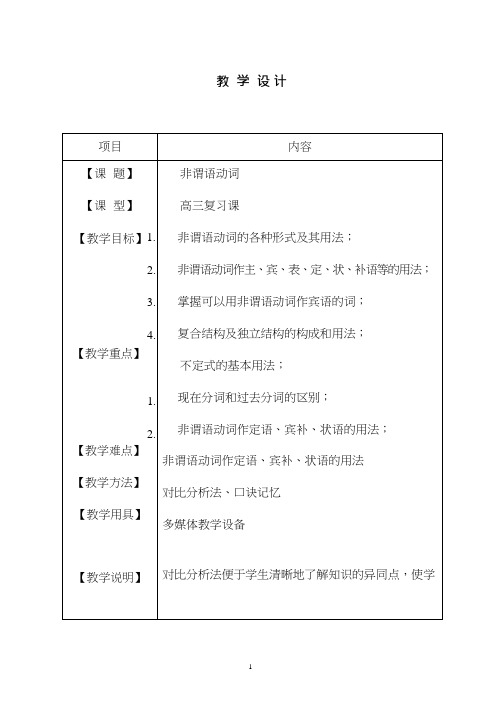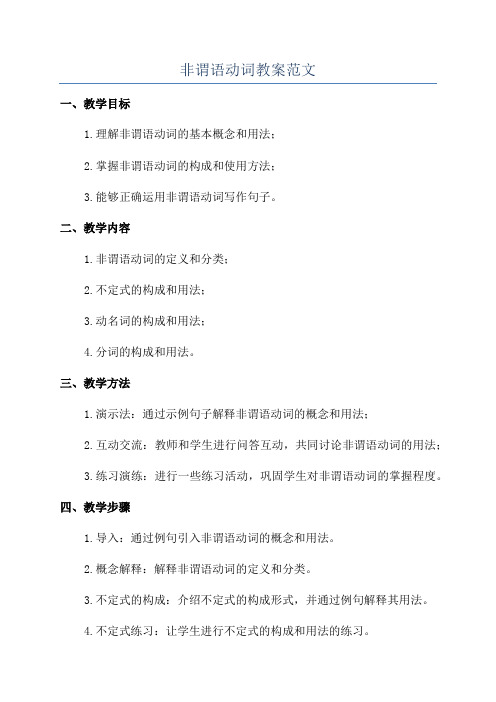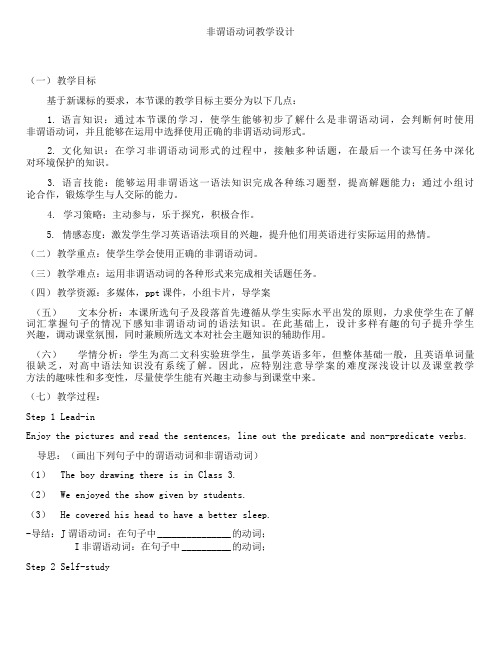高考英语 非谓语动词教案
高中英语《非谓语动词》优质课教案、教学设计

教学设计生能够从整体上把握知识脉络。
通过口诀记忆,使学生快速掌握,不容易遗忘。
在教学过程中,通过提问、启发等方式师生共同完成知识脉络,以达到较牢固的记忆及较理想的复习效果。
非谓语动词经常出现在高考题的语法填空、短文改错中,教学过程中的精选习题有助于学生及时地更好地掌握这部分语法知识。
【教学过程】课前预习(12 个单句语法填空)设计意图:通过练习,总结非谓语动词的形式,使学生对本节课的内容有大概的了解。
一、高考考纲解读近三年高考主要考查非谓语动词的作用和形式。
在作用方面主要考查作宾语时用不定式还是动名词;作宾语、状语、补语时用不定式还是分词;它们作某一成分时的特殊情况及特殊结构。
在形式方面主要考查用一般式还是完成式、主动式还是被动式、现在分词还是过去分词。
设计意图:使学生明确教学大纲的要求,了解其在考试中的重要性。
二、非谓语动词考点(二轮复习专家解读)1.不定式作宾语与动词的-ing 形式作宾语的区别2.不定式作宾补vs.分词作宾补的区别3.不定式作状语和分词作状语的区别4.不定式、现在分词和过去分词作定语的区别5.不定式的主动式和被动式作定语的区别6.动名词的复合结构作宾语时的代词转化7.带to 不定式和不带to 不定式8.不定式符号的单独使用设计意图:使学生细化知识点,掌握重难点。
三、非谓语动词思维导图及图表结构(结合时态和语态)设计意图:运用思维导图,一目了然,帮助学生有效记忆。
四、非谓语动词的句法功能归纳考点一非谓语动词作状语1.动词不定式作状语2.分词作状语3.独立成分作状语易错警示某些动词的过去分词已经形容词化,且常用于一些系表结构中,此时这些过去分词只表示一种状态,作状语时不表示被动关系,其前不用being。
语法训练吧:1.As the light turned green ,I stood for a moment ,not ,and asked myself what I was going to do.A.moved B.moving C.to move D.being moved2.an important role in a new movie,Andy has got a chance to become famous.A.Offer B.Offering C.Offered D.To offer考点二非谓语动词作定语1.过去分词作定语:2.现在分词作定语:3.动词不定式作定语:4.现在分词与动名词作定语的区别:语法训练吧:1.The idea you thought of a bridge over the river there sounds reasonable.A.build B.to build C.building D.built2.The ability an idea is as important as the idea itself.A .expressingB .expressedC .to expressD .to be expressed考点三非谓语动词作补语1.感官动词(词组)“一感”:f ee l“二听”:h ea r,li ste n to“五看”:see, watch, notice, observe, look at +宾语+1) 不带to 的不定式(表示主动和完成)2)现在分词(表示主动和正在进行)3)过去分词(表示被动和完成)2.make +宾语+do “让…做…”(与宾语为主动关系)make +宾语+done“让…被做”…”(与宾语为被动关系)3.let +宾语+do “让…做…”(与宾语为主动关系)let +宾语+be done“让…被做…”(与宾语为被动关系)4.have +宾语+do sth. 使…做某事have +宾语+doing sth. 使…持续做某事have+宾语+done 使…被做(宾语与宾补为逻辑上的被动关系)have sth. to do 有事要做(不定式作定语)注:have + sb. +doing 若用于否定句,不能容忍或不允许某人做某事。
非谓语动词(教案)

非谓语动词一、教学目标:1. 让学生理解非谓语动词的概念和用法。
2. 培养学生正确运用非谓语动词进行句子构建和表达的能力。
3. 提高学生对英语句子结构的认知和运用能力。
二、教学内容:1. 非谓语动词的定义和分类:动词不定式、动名词和分词。
2. 非谓语动词的用法和功能:作主语、宾语、定语、状语等。
3. 非谓语动词在特定句型中的运用:如“have difficulty (in) doing sth.”,“would like to do sth.”等。
三、教学重点与难点:1. 非谓语动词的分类和用法。
2. 非谓语动词在句子中的功能和位置。
3. 非谓语动词在特定句型中的运用。
四、教学方法:1. 实例分析法:通过具体例句讲解非谓语动词的用法。
2. 练习法:设计各种练习题,让学生巩固所学知识。
3. 互动教学法:引导学生参与课堂讨论,提高课堂氛围。
五、教学步骤:1. 引入非谓语动词的概念,让学生初步了解非谓语动词。
2. 讲解非谓语动词的分类:动词不定式、动名词和分词。
3. 通过例句展示非谓语动词的用法和功能。
4. 分析非谓语动词在句子中的位置和作用。
5. 讲解非谓语动词在特定句型中的运用。
6. 设计练习题,让学生巩固所学知识。
7. 课堂互动:引导学生参与讨论,提高学生对非谓语动词的理解。
8. 总结本节课的主要内容,布置课后作业。
六、教学评价:1. 课后作业:要求学生完成一定数量的练习题,巩固本节课所学知识。
2. 课堂练习:观察学生在课堂练习中的表现,了解他们对非谓语动词的掌握程度。
3. 学生互评:鼓励学生之间相互评价,提高课堂互动。
七、课后作业:1. 请用非谓语动词完成下列句子:a. I (do) my homework every day.b. She (go) to the movies with her friends last night.c. He (have) difficulty (in) understanding the lecture.2. 请用非谓语动词改写下列句子,使其更简洁:a. I saw a interesting movie yesterday.b. She is always late for school.八、教学反思:1. 总结本节课的教学效果,反思教学方法的运用。
非谓语动词(教案)

非谓语动词(教案)第一篇:非谓语动词(教案)非谓语动词(教案)在英语中,不是用作句子的谓语,而是用于担任其他语法功能的的动词,称之为非谓语动词。
非谓语动词有三种:不定式、动名词和分词。
一.非谓语动词与谓语动词之区别:1.相同之处:1)可以有宾语:He bought a house.He was considering buying a house.He wanted to buy a house.2)可以被状语修饰:He always gets up very early.He is used to getting up early.3)可以有“体”式和语态的变化:She has finished her job.Having finished her work,she went home.She is treated fairly.She insisted on being treated fairly.4)可以有自己的逻辑主语:My wife often works late.I dislike my wife’s working late.It was a hot day.It being a hot day, we stayed home.2.不同之处:1)可以起名词作用(如:不定式和动名词),在句中作主、宾、表语。
Your duty is to look after the plaining is no use.2)可以起形容词作用(如:不定式和分词),在句中作表语、定语和宾语补足语等。
The vase is broken.He is the a nice person to work with.We found the story amusing.3)可以起副词作用(如:不定式和分词),在句中作状语。
They are working hard to win still greater victory.The sick man came in, supported by two nurses.二.不定式:1.作主语(常置于句末,而用代替其做形式主语)T o learn a foreign language is not easy.It is not easy(for me)to learn a foreign language.2.作表语My job is to look after the babies.What I would like you to do is to keep silent about it.3.作宾语He offered to go with us.I want to see him.He considered ithis duty to support his family.作宾语补语(在see, hear, observe, watch, feel, notice等感官动词以及let, make,have等动词后面,作宾补的不定式 to均省去)They asked him to sing a pop song at the concert.They heard him sing a pop song in the meeting room.He was heard to sing a pop song in the meeting room.4.作定语Do you have anything to eat in your bag? He is always the first to come and the last to leave.5.作状语In order to save the the child, he dived into the river.We are overjoyed to see you.6.不定式的逻辑主语:I found it impossible for him to do the job alone.7.连接词+不定式He will tell me how to use the dictionary.Where to get the book is what I want to know.He didn’t tell us where to go and when to set out.8.不定式的否定形式They decided not to give up trying.9.不定式的时态We are happy to be with you on this trip.She is sure to succeed in the election.I’m sorry to be troubling you at such a time.I’m glad to be working with you.I’m sorry to have kept you waiting.The enemy was reported to have surrendered two days before.10.不定式的语态This book is said to have been translated into many languages.It is an honour for me to be asked to speak here.三.动名词:1.作主语Saying so much is useless/no good/(of)no use It is useless/no good/(of)no use saying so much.Reading French is easier than speaking it.2.作表语My hobby is collecting stamps.My great pleasure is learning English.3.作宾语(下列动词只能接动名词avoid, consider, deny, enjoy, escape,finish, mind, keep, practise, miss,regret, insist on, give up, put off, object to)He enjoys listening to classical music.We must avoid making such mistakes again.I wouldn’t mind waiting for another ten minutes.(有些动词后面可接动名词,也可接不定式:begin, start, continue, like, hate, prefer但动名词表示的意义是在一般情况下的行为,而不定式则表示某个具体的、一次性的行为。
高三英语高考非谓语动词教案

word[专题要点]非谓语动词和独立主格结构主要用法如下:1.动名词和动词不定式作主语、宾语;2.只跟动名词作宾语的动词或动词短语;3.只跟动词不定式作宾语的常见动词;4.既可以跟动名词又可以跟动词不定式作宾语,且意义不同的动词或短语;5.不定式、现在分词、过去分词作宾语补足语的区别;6.不定式、现在分词、过去分词作定语时的区别;7.不定式、现在分词、过去分词作状语时的区别;8.动名词的复合结构在句中作状语;9.there be 结构的两种非谓语形式;10.独立主格结构在句中作状语;11.with复合结构在句中作状语或定语。
[教法指引]非谓语动词包括不定式、v-ing形式和过去分词,是高中英语学习的难点,也是高考考查的重点。
高中英语非谓语动词是一个重要考点,教师在引导学生复习备考中要注意重点突出、训练得当,尤其是对以下要点的复习:1.不定式、现在分词与过去分词的用法区别;2.非谓语动词的主动式与被动式;3.非谓语动词完成式的用法;4.非谓语动词用作伴随状语;5.非谓语动词用作目的状语;6.非谓语动词用作结果状语;7.非谓语动词用作宾语补足语;8.非谓语动词的逻辑主语问题;9.非谓语动词用作主语的问题;10.“(be+)过去分词+介词〞结构;11.动名词的复合结构和there be结构的非谓语动词形式。
对于独立主格结构的复习,教师必须要讲清它的构成方式和在句子中的作用以及与with复合结构和分词之间的辨析的关系。
[知识网络]非谓语动词主要包括不定式、动名词和现在分词。
为了区分这三种不同的非谓语动词的用法和含义,我们将分别从三种非谓语动词在句子中做主语、宾语、宾语补足语、定语、状语、表语以及一些特殊结构句型等角度来区分其用法和细微含义。
1.不定式和动名词作主语的区别(1)动名词作主语通常表示抽象动作;而不定式作主语表示具体动作。
Smoking is prohibited(禁止)here.这里禁止抽烟。
(非谓语动词)教案

(非谓语动词)教案一、教学目标:1. 让学生理解非谓语动词的概念和用法。
2. 使学生能够正确选择和使用非谓语动词。
3. 培养学生运用非谓语动词进行交际的能力。
二、教学内容:1. 非谓语动词的分类:动词不定式、动名词和分词。
2. 非谓语动词的用法和句子结构。
3. 非谓语动词在语境中的实际应用。
三、教学重点与难点:1. 重点:非谓语动词的分类、用法和句子结构。
2. 难点:非谓语动词在语境中的运用和区分。
四、教学方法:1. 任务型教学法:通过完成具体任务,让学生实践非谓语动词的用法。
2. 交际型教学法:通过角色扮演、小组讨论等形式,培养学生运用非谓语动词进行交际的能力。
3. 案例分析法:分析典型句子,让学生深入理解非谓语动词的用法。
五、教学过程:1. 导入:通过图片和情境引入非谓语动词的概念。
2. 讲解:讲解非谓语动词的分类、用法和句子结构。
3. 实践:让学生完成相关练习,巩固所学知识。
4. 交流:组织学生进行小组讨论,运用非谓语动词进行交际。
6. 作业:布置课后练习,巩固所学知识。
7. 反馈:及时对学生的学习情况进行反馈,鼓励优秀学生,帮助后进生。
六、教学评价:1. 课后作业:评估学生对非谓语动词知识的掌握程度。
2. 课堂练习:观察学生在实际语境中的运用能力。
3. 小组讨论:评价学生在团队合作中的交流和表达能力。
4. 角色扮演:评估学生在实际语境中的应变能力和交际技巧。
七、教学资源:1. 教材:选用适合学生水平的英语教材,提供相关知识点。
2. 图片:使用图片和图表辅助教学,增强学生的直观感受。
3. 情境模拟:设计真实的语境,让学生在实际场景中运用非谓语动词。
4. 网络资源:利用网络资源,提供更多的学习资料和练习题。
八、教学进度安排:1. 第1周:介绍非谓语动词的概念和分类。
2. 第2周:讲解非谓语动词的用法和句子结构。
3. 第3周:通过练习和实践,巩固非谓语动词的知识。
4. 第4周:组织小组讨论和角色扮演,提高交际能力。
高中英语《非谓语动词》教案

高中英语《非谓语动词》教案I. 教学目标在本节课中,学生将能够:1. 理解非谓语动词的概念和特点;2. 能够正确使用不定式、动名词和分词作为非谓语动词;3. 掌握非谓语动词在句子中的用法和意义;4. 通过练习和示范,提高运用非谓语动词的能力。
II. 教学重点1. 理解非谓语动词的概念和特点;2. 分辨不定式、动名词和分词的用法;3. 掌握非谓语动词在句子中的正确用法。
III. 教学准备1. 教学PPT;2. 板书工具。
IV. 教学过程Step 1: 引入1. 教师出示一段文字,并请学生找出其中的非谓语动词。
2. 学生回答后,教师解释非谓语动词的概念和特点。
Step 2: 学习不定式1. 教师给出不定式的定义,并用示例句子帮助学生理解。
2. 教师讲解不定式的构成和用法,并列举常见的不定式作用方式。
3. 学生通过练习填空,加深对不定式的理解。
Step 3: 学习动名词1. 教师给出动名词的定义,并用示例句子帮助学生理解。
2. 教师讲解动名词的构成和用法,并列举常见的动名词作用方式。
3. 学生通过练习填空,加深对动名词的理解。
Step 4: 学习分词1. 教师给出分词的定义,并用示例句子帮助学生理解。
2. 教师讲解分词的构成和用法,并分别介绍现在分词和过去分词的用法和作用方式。
3. 学生通过练习填空,加深对分词的理解。
Step 5: 总结和巩固1. 教师总结不定式、动名词和分词的用法以及它们在句子中的作用方式。
2. 学生通过小组讨论的方式,复述并分享所学的知识。
3. 教师扩展学生的思维,通过提问让学生思考更多使用非谓语动词的场景和方式。
V. 课后作业1. 完成课堂练习册上关于非谓语动词的习题;2. 阅读一篇文章,在文章中找出使用了非谓语动词的句子,并分析其作用方式;3. 准备下节课的复习内容。
VI. 教学反思本节课的教学过程中,学生通过多种方式进行了互动学习。
教师在讲解的过程中使用了丰富的示例和练习,帮助学生更好地理解和掌握非谓语动词的知识。
(完整版)非谓语动词教案

高考英语专题复习——非谓语动词概述1。
谓语动词:在句子中担任谓语的动词2。
非谓语动词:是动词的特殊形式(不定式、动名词、分词(现在分词、过去分词)),不能单独作谓语,在句中可以作除谓语外的所有成分(主语、宾语、状语等等)3。
非谓语动词使用条件一个句子当中,已经存在一个主句(谓语动词),又没有连词的情况下, 还有别的动词出现时。
She got off the bus, leaving her handbag on her seat.She got off the bus, but /and left her handbag on her seat.(一)动词不定式在句中充当的成分判断下划线部分充当什么成分。
• 1. To see you is glad。
=It’s glad to see you。
______________•2。
I want to see you. ______________•3。
I want him to see you。
______________•4。
My hope is to see you. ______________•5。
He is the man to see you. ______________• 6. I’m glad to see you. ______________7。
I went to see you。
______________8. He went home, only to find the bus had gone. ______________(1)作主语。
To see once is better than to hear a hundred times. 百闻不如一见To make money is not the only purpose of our life。
赚钱不是我们生活的唯一目的在很多情况下,常用it 来充当动词不定式的形式主语。
高中非谓语动词教案

高中非谓语动词教案【篇一:非谓语动词教案】(非谓语动词)period 1 infinitive(不定式)objectives1.to revise infinitive to get a better knowledge .2.to practice infinitive to grasp more .(非谓语动词——不定式、分词和动名词——在高中学习中是一个很重要的部分。
在每年的高考中,无论是全国卷还是省市卷都是必考部分,因此,对此部分的学习与掌握都是必要的。
考虑到其重要性以及内容较多,决定分部分进行全面复习,从基本概念入手,再从形式、功能、重难点等方面进行讲解,最后进行操练巩固,以达到复习的最佳效果。
) resources used grammar summary; the multimediai. revision and lead-in(复习与导入)show ss how important this part is.以2011年全国各省市高考卷中出现的非谓语导入。
ii. presentation(呈现)( on screen)归纳总结1 非谓语动词在句中所作的成分:归纳总结2 不定式的时态:不定式的语态(被动):归纳总结3 注意点:iii. practice(操练)高考链接1.(2011北京卷)25. it’s important for the figures _________ regularly.a. to be updatedb. to have been updatedc. to updated. to have updated2. (2011上海卷) 40. today we have chat rooms, text messaging, emailing… but we seem _____ the art of communicating face-to-face.a. losingb. to be losingc. to be lostd. having lost3. (2011浙江卷)19. if they win the final tonight, the team are going to tour around the city ______ by their enthusiastic supporters.a. being cheeredb. be cheeredc. to be cheeredd. were cheered4.(2011福建卷)27.the difference in thickness and weightfrom the earlier version makes the ipad 2 more comfortable____.a .held b. holding c. be held d. to hold5.(2011天津卷)7.passengers are permitted _____ only one piece of hand luggage onto the plane.a. to carryb. carryingc. to be carriedd. being carried6.(2011重庆卷)29.more tv programs, according to government to officials, will be produced _______people’s concern over food safety.a. to raiseb. raisingc. to have raisedd. having raised7 . (2011湖南卷)21 . the ability _____an idea is as important as the idea itself.a. expressingb. expressedc. to expressd. to be expressed8.(2011四川卷)11. simon made a big bamboo box _______ the little sick bird till it could fly. a. keep b. kept c. keeping d. to keep iv. language in use.(操练巩固—运用—提升)1.主语: 1.当今掌握一门外语真的很重要。
(非谓语动词)教案

一、教学目标1. 让学生理解非谓语动词的概念和用法。
2. 培养学生正确运用非谓语动词进行句子构建和表达的能力。
3. 提高学生对英语语法的认识和应用水平。
二、教学内容1. 非谓语动词的定义和分类:动词不定式、分词、动词-ing。
2. 非谓语动词的用法和功能:作为主语、宾语、定语、状语等。
3. 非谓语动词在句子中的时态和语态表现。
三、教学重点与难点1. 重点:非谓语动词的分类、用法和功能。
2. 难点:非谓语动词在句子中的时态和语态表现,以及与谓语动词的协调。
四、教学方法1. 采用实例分析和练习相结合的教学方法,让学生在实践中掌握非谓语动词的用法。
2. 运用多媒体教学手段,提高学生的学习兴趣和参与度。
3. 采用小组讨论和互动式教学,培养学生团队合作和沟通能力。
五、教学过程1. 导入:通过一个谜语引出非谓语动词的概念,激发学生的学习兴趣。
2. 讲解:讲解非谓语动词的定义、分类和用法,举例说明。
3. 练习:让学生进行非谓语动词的填空练习,巩固所学知识。
4. 拓展:介绍非谓语动词在句子中的其他功能,如定语和状语。
5. 总结:对本节课的内容进行总结,强调非谓语动词的重要性和应用。
6. 作业:布置相关的练习题,让学生课后巩固所学知识。
六、教学评价1. 评价方式:课堂练习、小组讨论、课后作业、笔试考试。
2. 评价内容:非谓语动词的分类、用法、功能以及时态和语态的表现。
3. 评价标准:学生能够正确运用非谓语动词构建句子,理解其在句子中的作用,掌握时态和语态的运用。
七、教学进度安排1. 课时:共10课时,每课时45分钟。
2. 教学计划:第1-2课时:介绍非谓语动词的概念和分类。
第3-4课时:讲解非谓语动词的用法和功能。
第5-6课时:非谓语动词在句子中的时态和语态表现。
第7-8课时:练习和巩固所学知识。
第9-10课时:教学评价和总结。
八、教学资源1. 教材:英语语法教程、非谓语动词专项练习册。
2. 多媒体教学课件:图片、视频、例句等。
高考英语 非谓语动词教案

高考语法非谓语动词复习巩固教案教学目标:1.区分谓语动词和非谓语动词2.掌握非谓语动词充当定语、状语、宾语补足语时的用法教学重难点:非谓语动词充当状语、定语在语法填空短文改错的应用过程与方法:用歌曲激发学生兴趣,引入谓语动词和非谓语动词的区分讨论解决非谓语动词充当定语状语宾语补足语时的用法探讨总结规律方法,进行实战演练巩固提高教具准备:多媒体白板,学案课时安排;1课时教学过程:Step1.lead in Listen to a song—Right here waiting while listening,sing along and fill in the blanks Oceans day after day And I slowly insane(变得疯狂).I your voice on the line. But it the painIf I you next to never .How we forever.Wherever you Whatever you I right here ( )for you) Whatever it Or how my heart breaksI right here( for you) I took for granted, all the timesThat I thought would somehow一起朗读并寻找歌词中的谓语动词非谓语动词My daring ,wearing a smile, used to give spring time in the late fall.心上的人儿有笑的脸庞,他曾在深秋给我春光,My darling, possessing countless treasures offered me bright future,心上的人儿有多少宝藏,他能在黑夜给我太阳。
How can I let others take away my only springtime.我不能够给谁夺走仅有的春光。
非谓语动词教案范文

非谓语动词教案范文一、教学目标1.理解非谓语动词的基本概念和用法;2.掌握非谓语动词的构成和使用方法;3.能够正确运用非谓语动词写作句子。
二、教学内容1.非谓语动词的定义和分类;2.不定式的构成和用法;3.动名词的构成和用法;4.分词的构成和用法。
三、教学方法1.演示法:通过示例句子解释非谓语动词的概念和用法;2.互动交流:教师和学生进行问答互动,共同讨论非谓语动词的用法;3.练习演练:进行一些练习活动,巩固学生对非谓语动词的掌握程度。
四、教学步骤1.导入:通过例句引入非谓语动词的概念和用法。
2.概念解释:解释非谓语动词的定义和分类。
3.不定式的构成:介绍不定式的构成形式,并通过例句解释其用法。
4.不定式练习:让学生进行不定式的构成和用法的练习。
5.动名词的构成:介绍动名词的构成形式,并通过例句解释其用法。
6.动名词练习:让学生进行动名词的构成和用法的练习。
7.分词的构成:介绍分词的构成形式,并通过例句解释其用法。
8.分词练习:让学生进行分词的构成和用法的练习。
9.总结归纳:对非谓语动词的构成和用法进行总结归纳。
10.拓展延伸:让学生用非谓语动词写出句子,并进行批评指正。
五、教学评价1.观察学生在课堂上的表现,包括参与度、理解程度和运用能力等;2.对学生的练习作业进行评价,包括正确性、流利度和灵活运用程度等。
六、教学反思通过本节课的设计和实施,学生可以了解到非谓语动词的概念和用法,并能够运用非谓语动词写作句子。
但是,在教学中还可以加入更多的案例和互动活动,以提高学生的学习兴趣和参与度。
(非谓语动词)教案

非谓语动词教案一、教学目标:1. 让学生掌握非谓语动词的概念和用法。
2. 培养学生正确运用非谓语动词进行句子构建和表达的能力。
3. 提高学生对英语语法的理解和运用水平。
二、教学内容:1. 非谓语动词的分类:动词不定式、动名词和分词。
2. 非谓语动词的用法和句型结构。
3. 非谓语动词在句子中的功能和作用。
三、教学重点与难点:1. 重点:非谓语动词的分类、用法和句型结构。
2. 难点:非谓语动词在句子中的功能和作用,以及与主句的逻辑关系。
四、教学方法:1. 采用任务型教学法,让学生在实践中学习和运用非谓语动词。
2. 运用案例分析法,通过具体例句讲解非谓语动词的用法。
3. 采用互动式教学法,鼓励学生积极参与,提高课堂效果。
五、教学过程:1. 引入:通过一个谜语引发学生对非谓语动词的好奇心,如:“What do you calla person who doesn't do anything?(答案:Idler)2. 讲解:a. 非谓语动词的分类及定义b. 非谓语动词的用法和句型结构c. 非谓语动词在句子中的功能和作用3. 练习:a. 填空练习:使用非谓语动词完成句子b. 句子改写:将句子改为使用非谓语动词的形式c. 小组讨论:分析并纠正句子中的非谓语动词错误4. 拓展:介绍非谓语动词在特定语境中的应用,如:固定搭配、被动语态等。
6. 作业布置:a. 抄写并背诵本节课的重点句型b. 完成课后练习册的相关题目c. 搜集含有非谓语动词的例句,进行交流分享六、教学评估:1. 课堂参与度:观察学生在课堂活动中的参与程度,是否积极提问和回答问题。
2. 练习完成情况:检查学生完成练习的情况,包括正确性和完整性。
3. 作业质量:评估学生作业的完成质量,包括语法正确性、表达清晰度等。
4. 小组讨论:观察学生在小组讨论中的表现,包括合作态度、贡献程度等。
七、教学反思:1. 教师应反思教学内容是否清晰易懂,是否需要调整教学进度和难度。
非谓语动词教案 高考英语一轮复习

非谓语动词教学设计(一)教学目标基于新课标的要求,本节课的教学目标主要分为以下几点:1.语言知识:通过本节课的学习,使学生能够初步了解什么是非谓语动词,会判断何时使用非谓语动词,并且能够在运用中选择使用正确的非谓语动词形式。
2.文化知识:在学习非谓语动词形式的过程中,接触多种话题,在最后一个读写任务中深化对环境保护的知识。
3.语言技能:能够运用非谓语这一语法知识完成各种练习题型,提高解题能力;通过小组讨论合作,锻炼学生与人交际的能力。
4.学习策略:主动参与,乐于探究,积极合作。
5.情感态度:激发学生学习英语语法项目的兴趣,提升他们用英语进行实际运用的热情。
(二)教学重点:使学生学会使用正确的非谓语动词。
(三)教学难点:运用非谓语动词的各种形式来完成相关话题任务。
(四)教学资源:多媒体,ppt课件,小组卡片,导学案(五)文本分析:本课所选句子及段落首先遵循从学生实际水平出发的原则,力求使学生在了解词汇掌握句子的情况下感知非谓语动词的语法知识。
在此基础上,设计多样有趣的句子提升学生兴趣,调动课堂氛围,同时兼顾所选文本对社会主题知识的辅助作用。
(六)学情分析:学生为高二文科实验班学生,虽学英语多年,但整体基础一般,且英语单词量很缺乏,对高中语法知识没有系统了解。
因此,应特别注意导学案的难度深浅设计以及课堂教学方法的趣味性和多变性,尽量使学生能有兴趣主动参与到课堂中来。
(七)教学过程:Step 1 Lead-inEnjoy the pictures and read the sentences, line out the predicate and non-predicate verbs.导思:(画出下列句子中的谓语动词和非谓语动词)(1)The boy drawing there is in Class 3.(2)We enjoyed the show given by students.(3)He covered his head to have a better sleep.-导结:J谓语动词:在句子中_______________ 的动词;I非谓语动词:在句子中__________ 的动词;Step 2 Self-studyTask 1学会判断何时使用非谓语动词(1)The girl (dance) in the classroom now.一导思:该句中__________ (有/没有)谓语动词,所以该空格应使用_______ (谓语/非谓语动词),时态为______________ O(2)The girl ________ (dance) in the classroom now and she looks very confident.一导思:该句中_________ (有/没有)谓语动词,但是有并列连词_________ 连接了两个动词,所以空格应使用________ (谓语/非谓语动词),并且前后两个动词时态 _________ (一致/不一致)。
英语非谓语动词教案

英语非谓语动词经典教案第一章:非谓语动词概述1.1 非谓语动词的定义非谓语动词是指在句子中不充当谓语成分的动词形式。
非谓语动词包括动名词、分词和不定式三种形式。
1.2 非谓语动词的作用非谓语动词在句子中可以作主语、宾语、定语、状语等成分。
非谓语动词可以用来表示动作的进行、状态、结果、原因等。
第二章:动名词2.1 动名词的构成动名词由动词的现在分词形式加上-ing构成。
一些动词在变为动名词时,需要双写词尾字母再加-ing。
2.2 动名词的用法动名词作主语、宾语、定语、状语等成分。
动名词表示一般性动作,可以表示经常性、习惯性的动作。
第三章:分词3.1 分词的构成分词有现在分词和过去分词两种形式。
现在分词由动词的过去分词形式加上-ing构成,过去分词则是由动词的过去分词形式直接构成。
3.2 分词的用法分词作状语时,可以表示时间、原因、条件、方式等。
分词作定语时,可以修饰名词,表示名词的特征或属性。
第四章:不定式4.1 不定式的构成不定式由动词的现在分词形式加上to构成,有时to可以省略。
4.2 不定式的用法不定式作主语、宾语、定语、状语等成分。
不定式表示具体的、一次性的动作,可以表示目的、结果、原因等。
第五章:非谓语动词的辨析与运用5.1 动名词、分词和不定式的区别与联系动名词表示一般性动作,分词表示持续性动作,不定式表示具体性动作。
动名词作主语时表示泛指,分词和不定式作主语时表示特指。
分词作定语时表示名词的特征或属性,不定式作定语时表示名词的具体身份或作用。
5.2 非谓语动词在句子中的运用根据句子的意义和语法结构,选择合适的非谓语动词形式。
注意非谓语动词在句子中的作用和意义,避免混淆和错误使用。
第六章:非谓语动词的时态和语态6.1 非谓语动词的时态非谓语动词的时态变化主要体现在不定式和动名词上。
不定式和动名词都可以使用进行时、完成时和完成进行时态。
6.2 非谓语动词的语态非谓语动词的语态变化主要体现在分词上。
非谓语动词英语版教案

非谓语动词英语版教案非谓语动词英语版教案【篇一:高二英语非谓语动词教案】非谓语动词动词的非谓语形式有三种:不定式、动名词和分词。
一、不定式:it is hard for me to do the work. 作主语he wants to speak at the meeting.作宾语i have a lot of work to do. 作定语he asked me to finish it in time. 作宾补my job is to help the patient.作表语he is too young to go to school. 作结果状语we were surprised to find him there. 作原因状语he spoke loudly to make herself heard. 作目的状语he went to his home, only to find he was out. 出乎意料的结果特点1)不定式短语做主语时,往往放在谓语之后,用it作形式主语,(例1)2)不定式作宾语,如果还带有宾语补足语,往往把不定式宾语放在宾补之后,而用it作形式宾语,请看下句:i find it interesting to study english.3) 不定式作宾补,在feel, hear, listen to, look to, notice, observe, see, watch, have , let, make等词后的补足语,不定式不带to, 但这些句子变成被动结构就必须带to.二、动名词:动名词形式由“动词+ing”构成,具有动词和名词的性质,在句中起名词作用,可作主语,表语,宾语和定语。
请看例句:1)收集信息)is very important to businessmen.作主语与他争论)作主语3)看完这本书)yesterday. 作宾语书房)作定语特点:1.在it is no use/good, no any use/good, useless等后须用动名词作主语,泛指抽象动作.2 在finish,mind, enjoy, pactise, avoid, imagine, consider, feel like, keep, prevent, risk,suggest等词后,一定用动词的ing形式。
高考英语一轮复习非谓语动词教案

例如:(分析下列句子中主语和动词的主被动和先后关系)
1,Hearing the teacher's voice, the pupils stopped talking at once.
一听到老师的声音,学生们立刻停止讲话。
被他的父母所鼓励,他还是没有克服困难的信心。
4.The hunter walked slowly in the forest,followed by his dog.
猎人在前面慢慢地走着,后面跟着他的狗。
题目:
1.The hospital has recently obtained new medical equipment, _______(allow)more patients to be treated.
Have you got anything to be sent?
题目:We are having a meeting in half an hour. The decision ______(make)at the meeting will influence the future of our company.
高中非谓语动词专项教案
教学内容:
非谓语动词
教学目标:
1、学生能够明白非谓语动词的含义和类型
2、学生能够正确使用非谓语动词
3、学生能够理解非谓语动词在句子中作何种成分
教学重点、难点:
1、非谓语动词作状语
2、非谓语动词作主语
课前导入:
找出下列句子中含有的非谓语动词并分析它们在句子中做什么成分:
比如:
To save class time,our teacher had our students do half of the exercises in class.
英语非谓语动词教案

英语非谓语动词经典教案第一章:非谓语动词概述1.1 非谓语动词的定义1.2 非谓语动词的分类:不定式、动名词和分词1.3 非谓语动词的作用和用法第二章:不定式2.1 不定式的构成2.2 不定式的基本用法:作主语、宾语、表语、定语和状语2.3 不定式的特殊用法:不定式的进行式、完成式和过完式第三章:动名词3.1 动名词的构成3.2 动名词的基本用法:作主语、宾语、表语和定语3.3 动名词的特殊用法:动名词的进行式和完成式第四章:分词4.1 分词的构成:现在分词和过去分词4.2 分词的基本用法:作状语、定语和补语4.3 分词的特殊用法:分词的独立主格结构和分词的完成式第五章:非谓语动词的辨析和运用5.1 不定式、动名词和分词的辨析:根据句意和语法功能进行判断5.2 非谓语动词在特定语境中的运用:例如条件句、疑问句、否定句等5.3 非谓语动词的实践练习:通过练习提高对非谓语动词的运用能力第六章:不定式的特殊句型6.1 不定式短语作主语的句型6.2 不定式短语作宾语的句型6.3 不定式短语作表语和定语的句型第七章:动名词的特殊句型7.1 动名词短语作主语的句型7.2 动名词短语作宾语的句型7.3 动名词短语作表语和定语的句型第八章:分词的特殊句型8.1 现在分词短语作状语的句型8.2 过去分词短语作定语和补语的句型8.3 现在分词和过去分词的完成式的句型第九章:非谓语动词的翻译技巧9.1 不定式、动名词和分词的翻译方法9.2 非谓语动词在长句和复杂句中的翻译技巧9.3 非谓语动词在文学作品和日常交流中的翻译实践第十章:非谓语动词的测试与评估10.1 非谓语动词的测试形式:选择题、填空题、改错题等10.2 非谓语动词的测试重点:用法、时态、语态、搭配等10.3 非谓语动词的评估方法:自我评估、同伴评估和教师评估重点和难点解析一、非谓语动词的分类:不定式、动名词和分词解析:非谓语动词的三种形式在用法和语义上有所不同,需要重点掌握每种形式的特点和适用场合。
(非谓语动词)教案

高考复习专题——非谓语动词教案教学目标:复习非谓语动词基本知识,确保学生能够熟练使用非谓语动词,确保学生在选择题中不犯错。
教学重点:非谓语动词的三种基本形式动词不定式的基本用法动名次的基本用法动词过去分词的基本用法教学难点:非谓语动词三种形式用法区别分词、不定式作定语、状语、补语的用法动名词作主语、宾语的用法现在分词、过去分词、动名词及不定式的用法区别动词不定式常见用法错误动名词的常见用法错误动词过去分词的常见用法错误教学过程:一、由简单的动词复习开始引入,提出非谓语动词的概念二、从学过的句型以及例题中进行提炼,引导学生归纳出非谓语动词的三种形式三、由浅入深,带领学生学习动词不定式,动名词和动词过去分词。
四、根据学生情况,对知识点做出分类:1、简要进行复习的基础知识部分2、需做题练习巩固的知识部分3、易错知识点五、根据分类和学生掌握情况,进行一定量的举例,翻译练习,帮助学生熟悉使用非谓语动词六、指导学生完成非谓语动词基础练习题,易错类型练习题,并评讲,确保学生掌握。
非谓语动词知识点一、基础知识部分:非谓语动词(一)——分词【基本概念】1.对英语动词的基本认识英语中动词的语法作用同汉语区别很大。
动词除了在句子中充当谓语之外,还常以非谓语的形式充当其他的句子成分。
按照动词是否充当谓语,我们可以把动词分为谓语动词和非谓语动词两类。
每一类动词所包含的主要语法知识如下。
时态(按高考要求共九个时态)谓语动词语态(主动语态和被动语态)语气(陈述语气和虚拟语气)主谓一致动词动词不定式非谓语动词分词(现在分词和过去分词)动名词非谓语动词是指不充当谓语而做其他句子成分的动词,凡是用作非谓语的动词在形式上都要有所变化,以区别于谓语动词。
分词的语法作用分词分现在分词和过去分词两类,具有形容词和副词的语法功能,在句子中可以充当表语、定语、状语和宾语补足语。
2.掌握主谓关系用现在分词,动宾关系用过去分词的基本原则。
①分词做定语时,看分词同它所修饰的名词或代词的关系。
- 1、下载文档前请自行甄别文档内容的完整性,平台不提供额外的编辑、内容补充、找答案等附加服务。
- 2、"仅部分预览"的文档,不可在线预览部分如存在完整性等问题,可反馈申请退款(可完整预览的文档不适用该条件!)。
- 3、如文档侵犯您的权益,请联系客服反馈,我们会尽快为您处理(人工客服工作时间:9:00-18:30)。
高考语法非谓语动词复习巩固教案教学目标:1.区分谓语动词和非谓语动词2.掌握非谓语动词充当定语、状语、宾语补足语时的用法教学重难点:非谓语动词充当状语、定语在语法填空短文改错的应用过程与方法:用歌曲激发学生兴趣,引入谓语动词和非谓语动词的区分讨论解决非谓语动词充当定语状语宾语补足语时的用法探讨总结规律方法,进行实战演练巩固提高教具准备:多媒体白板,学案课时安排;1课时教学过程:Step1.lead in Listen to a song—Right here waiting while listening,sing along and fill in the blanks Oceans day after day And I slowly insane(变得疯狂).I your voice on the line. But it the painIf I you next to never .How we forever.Wherever you Whatever you I right here ( )for you) Whatever it Or how my heart breaksI right here( for you) I took for granted, all the timesThat I thought would somehow一起朗读并寻找歌词中的谓语动词非谓语动词My daring ,wearing a smile, used to give spring time in the late fall.心上的人儿有笑的脸庞,他曾在深秋给我春光,My darling, possessing countless treasures offered me bright future,心上的人儿有多少宝藏,他能在黑夜给我太阳。
How can I let others take away my only springtime.我不能够给谁夺走仅有的春光。
永远的微笑—周璇YOU are my eyes, guiding me to feel the rhythm of seasons.You are my eyes, guiding me to hustle through the huge crowds of people.林宥嘉I’m right here waiting for you.此情可待Eyes raised, I see the moon so bright; Head bent, in homesickness I am drowned.静夜思大家一起来找一找体会现在分词和过去分词充当谓语动词时的形式I am/was listening to a song.I have/had been listening to the song.I am/was/get/got praised by the teacher.I have /had been praised by the teacher.总结:现在分词前边必须有动词或的适当形式出现才能构成谓语动词,表示主动或进行;过去分词前边必须有动词或的适当形式,才能构成谓语动词表示完成或被动。
注意I praised Tom for his good behavior.中praised是过去式还是过去分词? 表示过去已结束的一个动作Step2对非谓语动词的再思考:The boy sat on the ground, crying.在以上例句中,crying为现在分词短语在句子中作_______状语,其逻辑主语是_ ;句子的谓语部分是_______,主语是_______。
一个句子中有个动词(包括谓语动词和非谓语动词),就要表达几层含义,非谓语动词的使用实现了一个分句里多层含义的表达。
请尝试将下列例句翻译成汉语:They were the poorest of the poor,fanning out(分散开来)into the city.▪总结:现在分词前边必须有动词或的适当形式出现才能构成谓语动词,表示主动或进行;过去分词前边必须有动词或的适当形式,才能构成谓语动词表示完成或被动。
▪非谓语动词的基本句法功能:非谓语动词在分句中主要充当_______、_______、_______, 起修饰作用;不定式短语和动名词短语还可以在分句中充当_______、_______,具有名词性特征。
▪谓语动词有时态语态形式的变化。
Step3学生分组探讨,教师精讲规律方法1.翻译句子体会非谓语动词作状语的形式与含义(第一组每人读并翻译一个句子)To catch the early bus,I get up early.Seeing the police, the thief ran off.Having finished the work, I went to bed.Having been told many times, he still can’t understand it.Seen from the hill, the city looks more beautiful.总结:不定时作状语表示现在分词作状语表示过去分词作状语表示如果分词作状语并且分词中的动作先于主句动作发生则用作状语,并且此种形式只有在作状语时才能用到。
2.翻译句子体会非谓语动词作定语时的形式与含义(第二组每人读一句并翻译一句)The school to be built is intended for the disabled children.The school being built is intended for the disabled children.The school built last year is intended for the disabled children.The man standing there is a thief.The man tied to the tree is a thief.总结:不定时作定语to be done表示being done表示done 表示Doing 表示3.翻译体会非谓语动词作宾语补足语(第三组每人读一句并翻译一句)1、I found myself lying on the beach When I woke up.I found a strange person walking nearby our shop all day.I found myself locked in a dark room when I woke up.I saw him crossing/cross the street.I smell something burning.总结:现在分词作宾语补足语强调动作的延续性,表示动作。
过去分词作宾语补足语表示。
2、(第四组)感官动词We heard her singing next door. 我们听到他在隔壁唱歌。
(主动进行)I think the job (to be ) the easiest of all. 我认为这是所有工作当中最容易的。
We heard her often sing next door. 我们听到他在隔壁唱过歌。
主动完成)We heard the song sung by her next door. 在隔壁我们听见这首歌被他唱过.。
(被动完成)We heard the song being sung next door. 我们听见在隔壁有人正唱这首歌。
(被动进行)现在分词或不定式作宾语补足语表示它与宾语之间是关系,用过去分词作宾语补足语一般表示它与宾语之间是关系、完成状态或动作由别人来完成。
过去分词作宾语补足语强调动作的,而动词不定式被动语态作宾语补足语强调动作的过程。
在want, wish, desire, like, expect等表示“意愿”的动词后的宾语补语如果用的是不定式被动语态,可省to be, 从而使语气显得更为毅然决然。
3、在think, consider, find等动词后常用to be +adj.结构作宾语补足语,有时to be 可省略。
We all discover him (to be) kind and honest. 我们都发现他既善良又诚实。
4.动名词作主语1、动名词多表示经常性习惯性的动作;不定时强调的是具体的某一次行为或将来的动作。
如:Reading English novels is really great fun. 读英语小说真有趣。
Taking exercise regularly is good for one’s health.Step4实战演练,精彩展示1-5题第五小组讨论并派代表展示:填什么及简单解释。
1. We’re having a meeting in half an hour. The decision (make)at the meeting will influence the future of our company.2. This machine is very easy (operate). Anybody can learn to use it in a few minutes.3. The old couple often take a walk after supper in the park with their pet dog _____(follow)them.4. Tom took a taxi to the airport, only (find)his plane high up in the sky.5. I looked up and noticed a snake (wind)its way up the tree to catch its breakfast.6-10题第六小组讨论并派代表展示;填什么及简单解释。
6. Before driving into the city, you are required to get your car (wash).7. (stand)in a long queue, we waited for the store to open to buy a new iPad.8. If he takes on this work, he will have no choice but (meet)an even greater challenge.9. (use)with care, one tin will last for six weeks.10. The old man sat in front of the television every evening, happy (watch)anything that happened to be on.11-15第七组讨论并派代表展示:填什么及简单解释11. The old man sat in front of the television every evening, happily (watch)anything that happened to be on.12. Birds’singing is sometimes a warning to other birds (stay)away.13. He got up late and hurried to his office (leave)the breakfast untouched.14. Film has a much shorter history, especially when (compare)to such art forms as music and painting.15. When (ask)for his views about his teaching job, Philip said he found it very interesting and rewarding.Home work1. Because of my new qualification, I’m getting _______(promote)at work.2. I found it all so _______(bore)and difficult. But Mr. Jenkins made everything _______(interest).3. Around the end of the first century AD, a Roman writer _______(call)Pliny wrote about a terrible volcanic eruption _______ he had witnessed as a young man.4. Pliny described a cloud _______(come)down the mountain, blocking out the sun and burying everything in its path, _______(include)whole villages and towns.5. In a way, Pompeii is like a “time capsule”_______(preserve)a frozen moment in history.6. One person, _______(sit)alone, looks like he is praying. Another man, _______(lie)on his side, looks as if he is trying to get up.7. Today, more than 250 years after scientists found the city, thousands of tourists and hundreds of scientists visitPompeii every year _______(learn)more about the ancient world.8. In other cultures, _______(look)thin for a husband-to-be is not _______ a woman desires for at all --- overweight is considered more attractive.9. However, _______(learn)English as a foreign language is very difficult in the _______(absent)of a native language environment.10. Some respected theories on language acquisition believe that _______(attain)a high level of fluency and accuracy in a foreign language, you need to be surrounded by it.11. Our latest English curriculum encourages teachers _______(create)a rich language environment in the classroom.12. However, _______(put)in those extra 15 minutes a day _______(do)take dedication.13. Body language _______(use)every single day by people of different nationalities all over the world. It is a language without words _______ consists of gestures, facial expressions and body movements _______ greatly add to –and sometimes even replace –spoken language.14. Since Bird Flu first appeared in 1997, it _______(take)more than a hundred lives.非谓语动词作主语补语和宾语补语的考查1. 在be said, be reported, be believed, be supposed等后常用动词不定式作主语补语。
